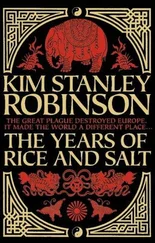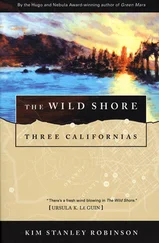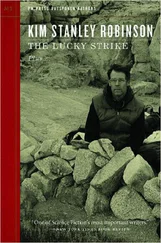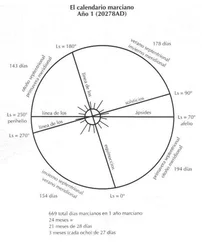I was involved throughout with our enology, and we made a good fumé blanc eventually, but my field work ended up being mostly in the almond orchards, strangely enough. It happened because I got caught up in the nutsedge problem. Early on we found some sedge creeping out of a radial-strip swamp into the vineyards, and I had gotten rid of it by direct removal. So when the almond orchards were infested I was called on to do it again there. But this time it wasn’t so easy. Nutsedge is one of several plants I wish they had never introduced to Mars, but it’s good in wet sandy areas, so at first people seeded it to help build meadows. It’s a very ancient plant, coevolved with dinosaurs, I suspect, making it very hardy; and impervious to most attempts at eradication. In fact I’ve come to believe it regards such efforts as friendly stimulation, like a massage. But I only found that out the hard way.
I can’t tell you how many days I spent out in our orchards weeding nutsedge. We had decided to be an organic farm, no chemical pesticides, so it was a matter of either biological control or hand-to-hand combat. I tried both, so what I was doing was integrated pest management. But ineffective no matter what you called it. For many hours I sat on the low ground at the southern end of the young almond trees, in what was in effect a ragged lawn of purple nutsedge. Cyperus rotundus . If it had been yellow nutsedge there would have been people in my group encouraging us to harvest it and eat the nuts. But purple nuts are hard brown gnarled oblong fibrous tubules, white inside and ghastly bitter to the tongue. They lie about half a meter below the ground, connected to the surface blades of grass by thin shoots that break at the slightest tug, and connected to each other underground by wiry rhizomes that also break easily, leaving the nuts behind. At first I thought I was succeeding when I loosened the soil and sifted through it to get all the nuts out of it. It was slow but not unpleasant work, sitting on the dirt in the sun, getting dirt under my fingernails, looking at the friable soil for the dirt clods that were actually living pebbles. The blades above, stacked in triplet tassels, V-shaped in cross section and stiffer than grass blades, I pulled and composted. The nuts I ground up and tossed in the supercooker compost, feeling superstitious. Which turned out to be not inappropriate given what happened.
A careful sifting of soil to a depth of half a meter, throughout the entire region of its growth—and the next spring the precise region I had weeded sprang forth in a thick lawn of young nutsedge. I couldn’t believe my eyes. That was when I got serious about my research, and found out about the Sedge Grass Support Group, and learned from them that fragments of the rhizomes only five hundred nanometers long had been observed to regenerate the full plant in a single growing season.
Some other method was called for. And around that time I got to take a break to regroup as well, as our farm began full participation in one of the ag labor rings of the River League, which meant we went out on the road as nomad farm labor for two months of the fall harvests, moving from farm to farm in the ring as the various crops came ready. Other groups passed through our place while we were gone, with Elke and Rachel left behind to supervise their work. I saw nutsedge in many other places around Jones Crater, and began to exchange stories and theories with the people who had tried to combat it. It was a nice way to meet people. I noticed that quite a few of them had become fanatical on the sedge issue without actually conquering their infestation, which struck me as a bad sign. But I got home that 2 November and tried cover-cropping, on the suggestion of someone who had said, “It’s a long-term project,” in a way that made me think this was not a bad thing to have in one’s life. So it was clover in the fall and winter and cowpeas in the spring and summer, always thickly matted over the sedge, which as a result sometimes did not appear for years at a time. But then if I was late planting a new spring cover crop by even a week, a carpet of tasseled green little pagodas would shove through the dying old cover crop, and it was back to square one. Once when a cowpea crop got beat to the punch I solarized the ground with clear plastic sheets, and recorded temperatures near boiling underneath it. Some IPM folks looked at it and estimated that everything had to have been killed down to twenty centimeters; but others said two; and though the plant matter on the surface was indeed toasted by the end of the summer, the moment I took the plastic off the green carpet came shooting back.
Tilling and drying the soil for four years was my next option. But then someone visiting the farm innocently suggested a new chemical pesticide that had gotten good results for the Namibians to the north.
That provoked a controversy. Some were content to continue pursuing the various fruitless strategies of the organic battle. Others suggested we give up and let the area become a sedge swamp. But because sedge seed-disperses as well as spreading by underground growth of the rhizomes, little patches of it were springing up everywhere downwind of my orchard lawn. And the wind blows in all directions eventually. So leaving it alone was not really acceptable. Meanwhile, eight years of combat had only made the lawn more luxuriant. You could have played croquet on my patch at that point.
So a majority of our group finally talked a small minority into a one-time exception to our organic policy, in order to make an application of some methyl 5-{[(4, dimethoxy-2-pyrimidinyl)amino]carbyonylaminosulfonyl}-3-chloro-1-methyl-1-H-pyrazole-4-carboxylate. When we did it we turned it into a kind of Balinese mask dance ceremony, and the people against the idea dressed as demons and cursed us, and we sprayed the stuff and left for an extended work trip. We harvested grapes in riverside vineyards and built stone drywall terracing, and saw parts of Her Desher Vallis, Nirgal Vallis, Uxboi Vallis, Clota Vallis, Ruda Vallis, Arda Vallis, Ladon Vallis, Oltis Vallis, Himera Vallis, and the Samara Valles. All these are little riverine canyons to the immediate southwest of Jones—beautiful country, reminiscent of the Four Corners area of North America, though our neighbors assure us it is also very like parts of central Namibia. Whatever; when we returned home, the land downslope to the southwest now seemed to suggest the beautiful little canyons that we knew broke the plateau even though we could not see them, canyons held now in our minds’ eye, sunken meandering gardens floored with streams and cottonwood islands. And the nutsedge was gone. Not all of it, but everything that we had sprayed. And if you catch it early enough new sedges do not have the regenerative ability of an established bed, because the nuts are not yet down there.
So we planted new ground cover under the blossoming almond trees, and life went on, the farm growing more luxuriant all the time. Of course things changed; Elke and Rachel moved to Burroughs, and later Matthew and Jan did too, complaining that among other things it was not an organic farm anymore, which made me feel bad. But the others in their house assured me that pesticide policy was the last thing they had been thinking of when they left; and I was shocked to hear what some of the other things were. Apparently I had been oblivious; and in fact, they all went on to tell me, no one else but me on the farm had considered the nutsedge problem to have been of much importance. What I had thought was a crisis and a knotty problem in invasion biology, they considered a matter of housekeeping, a mere irritant among more important issues, and, more than anything else, the bee in my bonnet.
Of course compared to the big climate shift that came later, this was probably the right way to regard it. But at the time it had mattered. Or I enjoyed it, whatever. Those were the years when everything mattered, really. We had nothing but each other. We were on our own, growing most of our food, making a lot of our tools, even our clothes, with all the kids growing up. We all grew up together. It matters, in a time like that, whether you can make your agriculture work or not.
Читать дальше
Конец ознакомительного отрывка
Купить книгу












